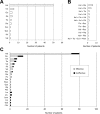"Diabetic striatopathy": clinical presentations, controversy, pathogenesis, treatments, and outcomes
- PMID: 32005905
- PMCID: PMC6994507
- DOI: 10.1038/s41598-020-58555-w
"Diabetic striatopathy": clinical presentations, controversy, pathogenesis, treatments, and outcomes
Abstract
Diabetic striatopathy (DS) is a rare medical condition with ambiguous nomenclature. We searched PubMed database from 1992 to 2018 for articles describing hyperglycemia associated with chorea/ballism and/or neuroimages of striatal abnormalities. Descriptive analysis was performed on demographic/clinical characteristics, locations of striatal abnormalities on neuroimages, pathology findings, treatment strategies, and outcomes. In total, 176 patients (male:female = 1:1.7) were identified from 72 articles with mean age 67.6 ± 15.9 (range, 8-92). Among them, 96.6% had type 2 DM with 17% being newly diagnosed. Average blood glucose and glycated hemoglobin concentrations were 414 mg/dL and 13.1%, respectively. Most patients (88.1%) presented with hemichorea/hemiballism. Isolated putamen and combined putamen-caudate nucleus involvements were most common on neuroimaging studies with discrepancies between CT and MRI findings in about one-sixth of patients. Unilateral arm-leg combination was the most frequent with bilateral chorea in 9.7% of patients. Chorea and imaging anomalies did not appear concomitantly in one-tenth of patients. Successful treatment rates of chorea with glucose-control-only and additional anti-chorea medications were 25.7% and 76.2%, respectively, with an overall recurrence rate being 18.2%. The most commonly used anti-chorea drug was haloperidol. To date, four out of six pathological studies revealed evidence of hemorrhage as a probable pathogenesis.
Conflict of interest statement
The authors declare no competing interests.
Figures





